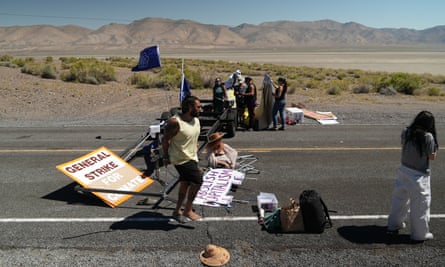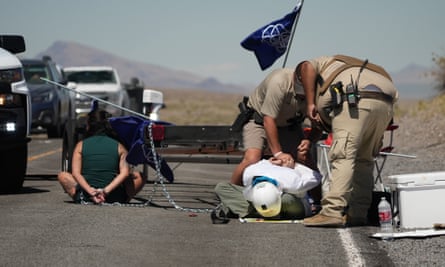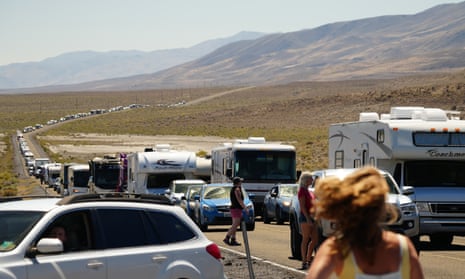The road into Burning Man is a rural, two-lane highway winding through north-west Nevada. Approximately 80,000 people make an annual pilgrimage to the beloved bacchanal, many hauling trailers and RVs across miles of scorching desert in order to make it to their fabled Gomorrah. This year, however, climate activists temporarily halted the influx of eager festivalgoers, blocking the road with a 28-foot trailer and causing a bumper-to-bumper traffic jam for over an hour. They clashed with outraged Burning Man attendees as well as Nevada rangers.
In recent years, Burning Man has drifted from its hippy roots and become better known for luxury RVs, wild orgies, and Silicon Valley bros. Protestors from the Seven Circles –a coalition of activists representing the climate groups Extinction Rebellion, Rave Revolution, and Scientist Rebellion – demanded that Burning Man ban private jets and single-use plastics, as well as unlimited generator and propane use. Signs painted with the slogans “Burners of the world, unite!”, “Mother Earth needs our help” and “System change” were erected around the blockade, while four activists chained themselves to the trailer and locked arms through PVC pipes.

The activists had driven to the site they’d chosen for the action in separate vehicles, stopping on the road while the driver of a trailer pulled ahead and turned to block both lanes. People in the cars stuck behind them initially believed there had been an accident, and they emerged from their vehicles asking if everyone was OK. The protesters scrambled to erect their signs and flags amid the confusion, and when onlookers realized it was a climate protest, many quickly became incensed, huffing back to their cars frustrated at the inconvenience. “They’re delusional, it’s idiocy,” fumed Molly, a festival attendee. “They think they’re going to fix climate change by blocking Burning Man? I don’t care what their argument is, they can go fuck themselves.”
The festival, which originated as an underground gathering in 1986 in San Francisco, has anarchist and countercultural roots. Unlike at a typical festival, participants build the event themselves, transforming a 4,000-acre dry lake bed into an ephemeral metropolis called Black Rock City, by bringing in their own infrastructure, food, water, and entertainment, in lieu of programmed musical headliners. Burning Man’s radical ethos also mandates that within the event’s grounds, no money can be exchanged, and brands are prohibited from advertising products.

However, in recent years Burning Man has gained a cultish popularity among Silicon Valley’s technocrats, as well as celebrities, influencers and others who treat the gathering as a photogenic opportunity to network, post selfies, and experiment with psychedelic drugs. Many in these moneyed ranks choose to spend the festival in gas-guzzling luxury RVs. Rising temperatures in Black Rock Desert, which hit a record 103F at last year’s edition, have led to an increasing reliance on air conditioning fueled by generators. Concerns over the illegal dumping of trash have led to federal officials capping attendance at 80,000, against the festival’s desire to continue growing.
“Burning Man attracts the elite of the elites to party and pretend they’re in a classless, moneyless society,” said Tommy Diacono, co-founder of Rave Revolution. “But more private jets than ever are flying to the Burn. We’re burning propane for fun. The air-conditioned domes are getting bigger every year.”
Emily Collins, another co-founder of Rave Revolution, added that the tech utopianism woven into Burning Man culture had engendered a sense of complacency amongst many of its attendees. “There are a lot of people thinking, oh, I’m a vegan, I drive an electric car, I’m working in sustainability,” she said. “It’s a very technocratic, privileged mindset.”
In addition to their concerns over Burning Man’s carbon footprint – which reached 100,000 tons of CO2 a year in 2019 – the activists hoped the protest would highlight how our climate emergency requires wider systemic change beyond the personally transformative experiences of self-realization that can occur at a festival.
Burning Man organizers say they are making an effort to be greener. In their 2023 sustainability report, festival organizers celebrated their recent successes: launching pilot programs for solar panels, offsetting their emissions through purchasing carbon credits, and supporting sustainability-minded camps as they work towards their goal of becoming carbon-negative by 2030. However, the activists believe these steps are insufficient to mitigate the catastrophic rate of global warming.

“The climate movement has reached a point where there is a split between climate mitigation through technological fixes, and climate justice that’s more oriented around systemic inequalities,” said Will Livernois, a scientist with Scientist Rebellion who donned a white chemist coat at the protest while sitting with a dejected look next to the trailer. “We have to shift away from Burning Man’s green capitalism and focus on degrowth.”
“We’re not moving fast enough to reach the 2030 net zero goals,” said Christina Chu, a member of Solarpunks, a climate-focused camp that built a solar panel-based community microgrid at the festival last year. “Burning Man has served as a catalyst for people like myself to create projects like this, but there’s a lot of room for improvement. A lot of this is grassroots, volunteer-based work that stops short of a top-down direction on how to decarbonize. Right now, it’s like: raise your hand if you’re using solar this year.”
Not all of the people stuck behind the roadblock were Burning Man attendees. In a fiery exchange, one man angrily shouted that he was a working-class person just trying to get to work. “I’m on your team, I promise,” Diacano tried to tell him. “The government doesn’t care about us.” The man shrugged and went back to his car.
“The individualization of systemic problems under late-stage capitalism is crazy,” Diacono later said. “There’s this mentality that I just need to change myself, and the world will change. But this current economic system has driven us to record inequality and record carbon in the air–and they are correlated.”
Many of the Burning Man attendees stuck in the traffic jam did not agree with the activists. Within minutes of the blockade being erected, several people had called the police to report the protesters, while others attempted to pick up and move the trailer themselves. One man crumpled up a flier an activist had handed to him that listed their demands, throwing it away in disgust. “I think protest is very important, but destroying and inconveniencing people doesn’t do anything,” said a man named Will Semmbs, who was on the way to the festival. “I have solar panels on my RV,” he noted. “The protesters drove here in gas-powered cars. They’re literally making the climate worse.”
Festivalgoers observing the commotion as they waited for the traffic jam to clear questioned why the protesters were targeting Burning Man, when the event has already made sustainability one of its core tenets. In addition to developing environmental solutions, the festival has a “leave no trace” mandate, under which participants and organizers must remove all trash and debris from the festival site when the party’s over. “We have principles that we try to live by, and a lot of them are cultural and environmental in nature,” said Benjamin Jorgens, a 10-year Burner. “Burning Man takes more precautions than any festival on the planet,” Jorgens said. “In fact, this is about as good as it gets.”
Nevada rangers drove directly into a blockade set up by climate protestors on the road to Burning Man. An officer pulled a gun out, tackling a protestor and threatening to shoot
— michelle lh࿊࿊q (@MichelleLhooq) August 28, 2023
Environmental activists were demanding that #BurningMan ban private jets + single-use plastics pic.twitter.com/dawDjxhV4y
Illustrating the complexities involved in the transition to green energy, Burning Man Project – the San Francisco-based non-profit behind the festival – is suing the Biden administration over an approved clean-energy project near Gerlach, the small town that serves as the gateway to the festival. Ormat, the company behind the development, has suggested that the carbon-free energy generated by the geothermal plants it plans to build near the festival site would offset the “copious amounts of fossil fuels” it says Burning Man emits every year in the desert. However, both the festival and the Indigenous Paiute Tribe claim the project could endanger local wildlife and dry up local hot springs in the area.
On Sunday, the activists were pitted against members of the Paiute Tribe, which owns the area surrounding the protest. Amid honking cars, members of the tribe told the activists that they were not allowed to stage their protest on tribal lands. The activists refused to move, pointing out that they were chained to the blockade. But onlookers were able to successfully move the trailer a few feet to the side, so that vehicles could slowly pass by on the shoulder, some full of people shouting obscenities at the protesters as they squeezed through.
At 1.36pm, just 36 minutes after the protestors had set up the blockade, officers from Pyramid Lake Paiute tribal police department arrived on scene with their sirens screeching. One officer told the protesters to disband within 30 seconds or risk arrest, commanding them to “get off the fucking road”. In those 30 seconds, a second ranger plowed through the blockade, his vehicle smashing the trailer and protest signs as activists still chained to it narrowly missed getting hit. “We’re non-violent, we have no weapons at all, we’re environmental protesters,” shouted Collins, as the officer pulled out what appeared to be a firearm and aimed it at the activists after threatening: “I am going to take all of you out.”

Fifteen minutes later, four activists were in handcuffs, with pending municipal code violations and a court date scheduled in October. It was over quickly but for Mun Chong, who sat in the back of the ranger vehicle in a green shirt that read “No Burn on a dead planet”, the act of civil disobedience was worthwhile. “If you treated the climate crisis like an emergency, Burning Man wouldn’t be a priority,” she said. “When you disrupt business as usual, you’re forcing people to confront a situation and take a stance. We’re hoping these kinds of protests become part of the zeitgeist.
“What is being late to Burning Man in comparison to having your entire planet on fire?”









